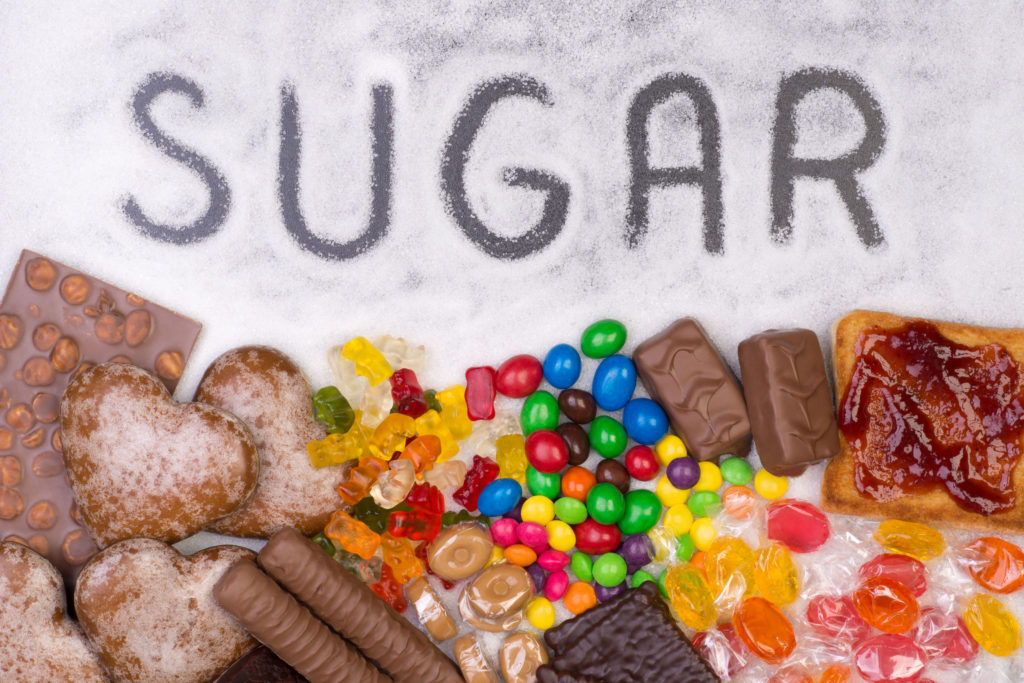In this post I outline healthy sweeteners to incorporate into your nutritional habit. But how do you make informed choices about what to eat when you are not able to make your own treats? Learning to read nutrition labels is an important step in taking control of your health and energy. Food companies use many different names for sugar on nutrition labels.
The reason for using lots of different names is that ingredients are listed in the order of how much of the ingredient is in the item, compared to the rest of the ingredients. Therefore the most abundant ingredient is listed first, but by using different types and names of sugar, food manufacturers can put it lower down on the list. So in a granola bar for example, the first ingredient may be oats, which seems healthy, but there may be 2 or 3 or even 4 kinds of sugar listed after it!
Here’s the ingredient list of a real-world bar aimed at kids. The ingredients are organic, which is a step in the right direction. But there is a lot of sugar in this list:
Oat blend (Rolled oats, oat flour, oat fiber), Tapioca syrup, Cane syrup, Fig paste, Cane sugar, Cocoa, Unsweetened chocolate, High Oleic Sunflower Oil, Natural Flavors, Cocoa Butter, Sea Salt, Baking Soda, Soy lecithin, Vanilla extract.
After the oat blend, the next four ingredients listed are all forms of sugar. Why do food manufacturers use so much sugar? Because eating foods loaded with sugar gives us a quick rush but doesn’t satiate us for very long, so we are hungry again quickly and reaching for another sugary snack.
Download my son Paul’s favorite granola bar recipe. Just 5 simple ingredients to make a bar that is moist, delicious, filling and sustaining. What’s not to love about that??
How much sugar is safe?
Before diving into the plethora of aliases for sugar, let’s talk about how much sugar one should be consuming in a day. The American Heart Association (AHA) recommends no more than 9 teaspoons (38 grams) for men and 6 teaspoons (25 grams) for women per day. Children, depending on their age, should consume no more than 3 – 6 teaspoons, (12 – 25 grams) of added sugar daily. For perspective, one 12 oz can of Coca Cola (any regular soda will fall into this category and diet sodas are not a better choice) has 39 grams of sugar, mostly from high-fructose corn syrup, a particularly damaging from of sugar. Many foods most people would consider “healthy” have large amounts of added sugar, such as granola bars, flavored yogurts, fruit juices, and so called “heart-healthy” cereals.
Quick side note: I’m not a fan of the AHA (read this post to find out why) but I think their guidelines for sugar intake are reasonable.
So what if I eat too much sugar?
We all know that eating too much sugar can lead to weight gain and cavities. No surprise there. But eating too much sugar over the long-term (years and decades) has been shown to dramatically increase the risk of many other serious health consequences, including but certainly not limited to insulin resistance, obesity, heart disease, Type 2 Diabetes, Alzheimer’s (known as Type 3 diabetes), cancer and more. In the shorter term, chronic over-consumption of sugar causes brain fog, fatigue, anxiety, acne, and accelerates the aging process. So avoiding added sugars is a wise strategy for long-term health.
What am I looking for?
So what should you be looking for on nutrition labels? Here is an incomplete list of different names for sugar you might find on nutrition labels:
Barley Malt, Barbados sugar, Beet sugar, Brown sugar, Cane juice, Cane sugar, Caramel, Corn syrup, Corn syrup solids, Dextrose, Diastatic malt, Diastase, Ethyl maltol, Fructose, Fruit juice, Fruit juice concentrate, Galactose, Glucose, High Fructose corn syrup, Honey, Lactose, Maltodextrin, Maltose, Malt syrup, Mannitol, Rice syrup, Sorbitol, Sorghum or Sorghum syrup, Sucrose, Sugar, Turbinado sugar.
Anything ending in -tol (Sorbitol or mannitol, for example), is a sugar alcohol that is hard to digest and can be detrimental to your microbiome, the collection of gut bacteria that works to keep you healthy. Keep in mind that even so-called “healthy” sugars (honey or cane sugar, for example) are likely highly processed and refined and any healthy aspects have been stripped out of them during the industrialization of the food-like substance that results at the end of the process. Most other sweeteners are derived from beets or corn, both of which are crops grown mostly from Genetically Modified Organisms, engineered to withstand high amounts of glyphosate, a toxic weed-killer that does enormous damage to our microbiome. Organically grown crops cannot be sprayed with glyphosate, so organic is always a better choice for that reason alone.
And never ever choose a food-like substance that contains artificial sweeteners. Artificial sweeteners are known neurotoxins that damage your brain and can lead to migraines, insomnia and other sleep problems, joint pain, depression, anxiety, memory loss, and more. And artificial sweeteners do not help you lose weight! They trick your body into thinking you ate something sweet, triggering an insulin response, and when there is no actual sugar to utilize, you are left feeling hungrier than before you consumed the artificial sweetener.
Just eat real food. And if you are ready to learn the nutritional habits that will form the foundation of health and energy for the rest of your life, check out my e-course “Six Weeks to Abundant Energy” HERE.
To Your Abundant Health and Energy!

